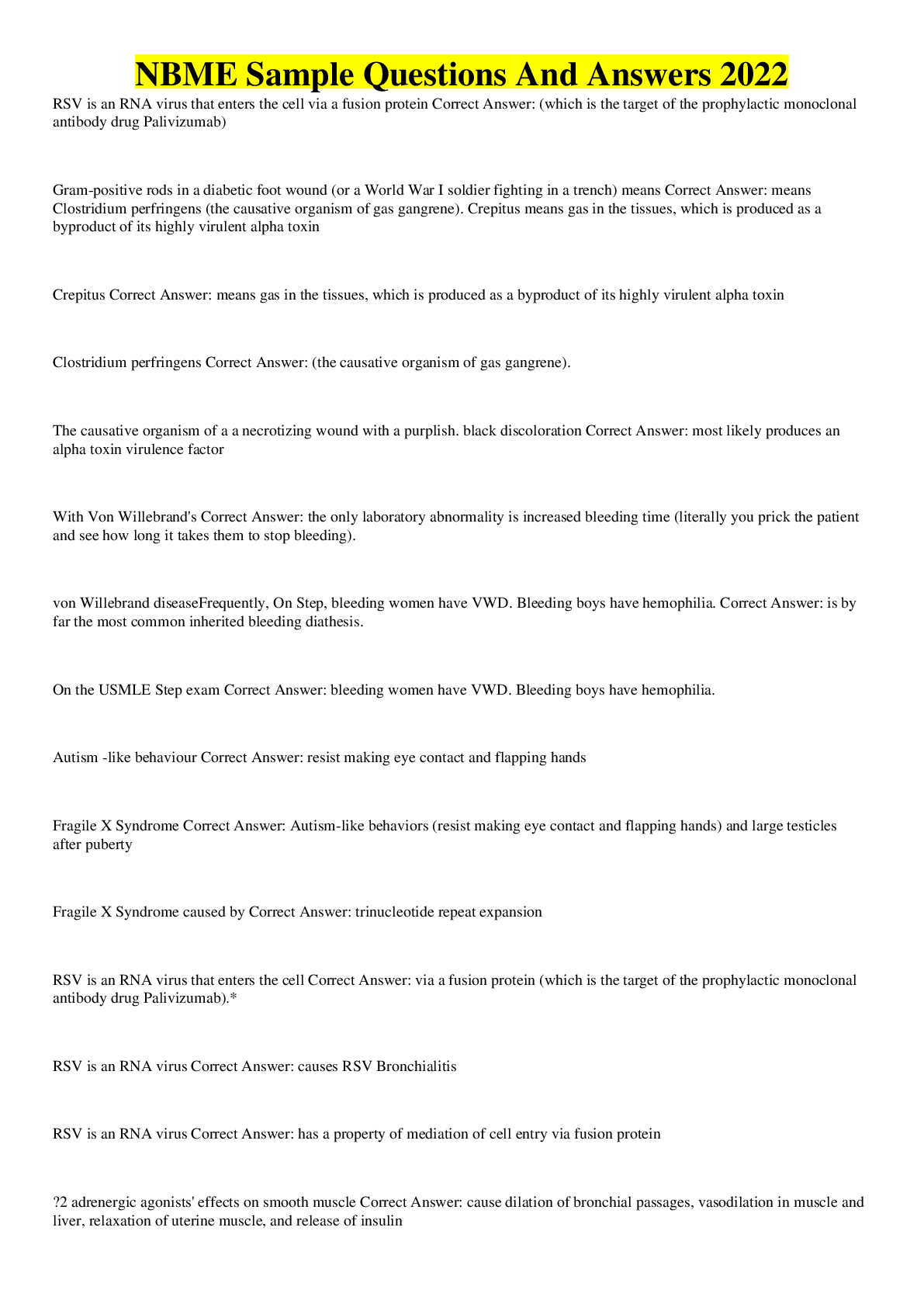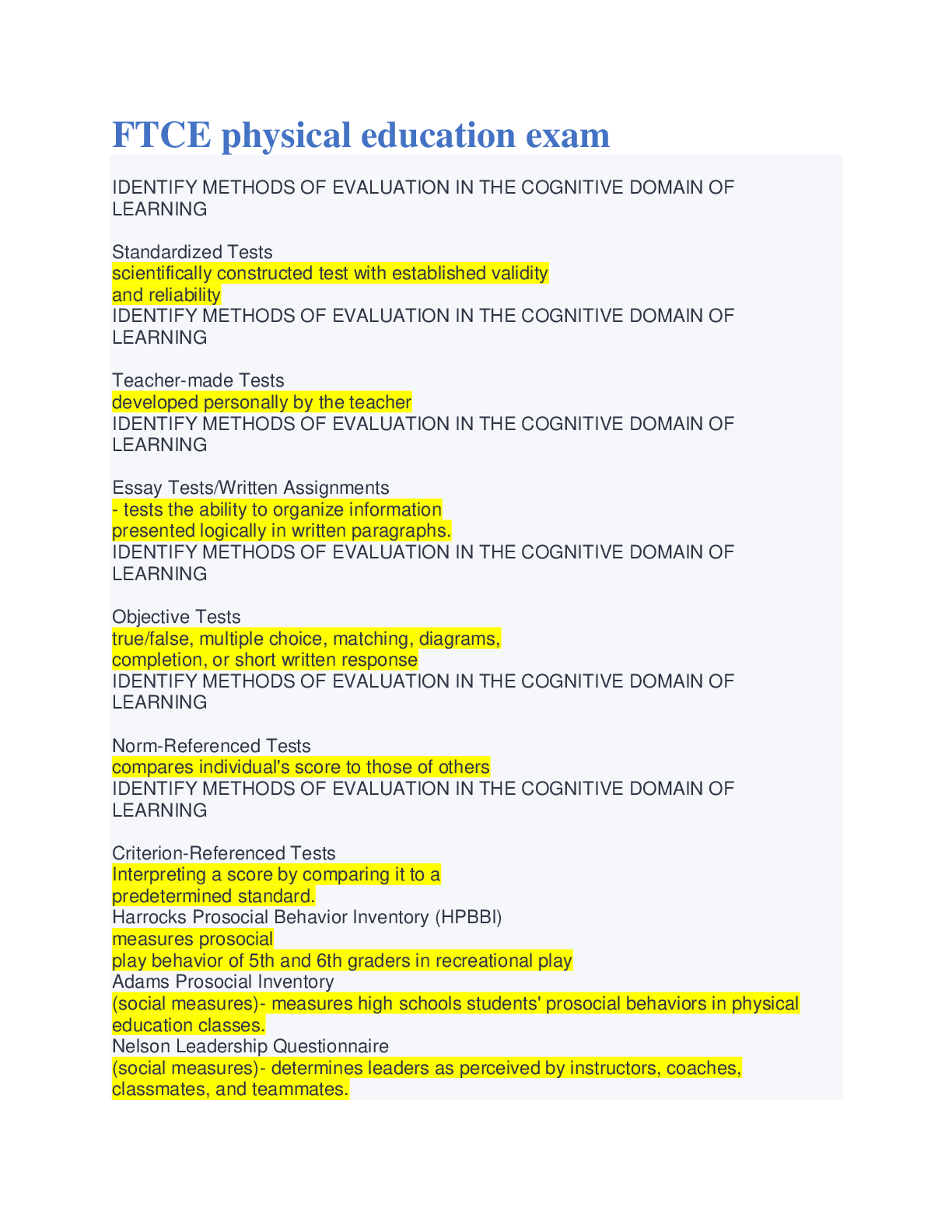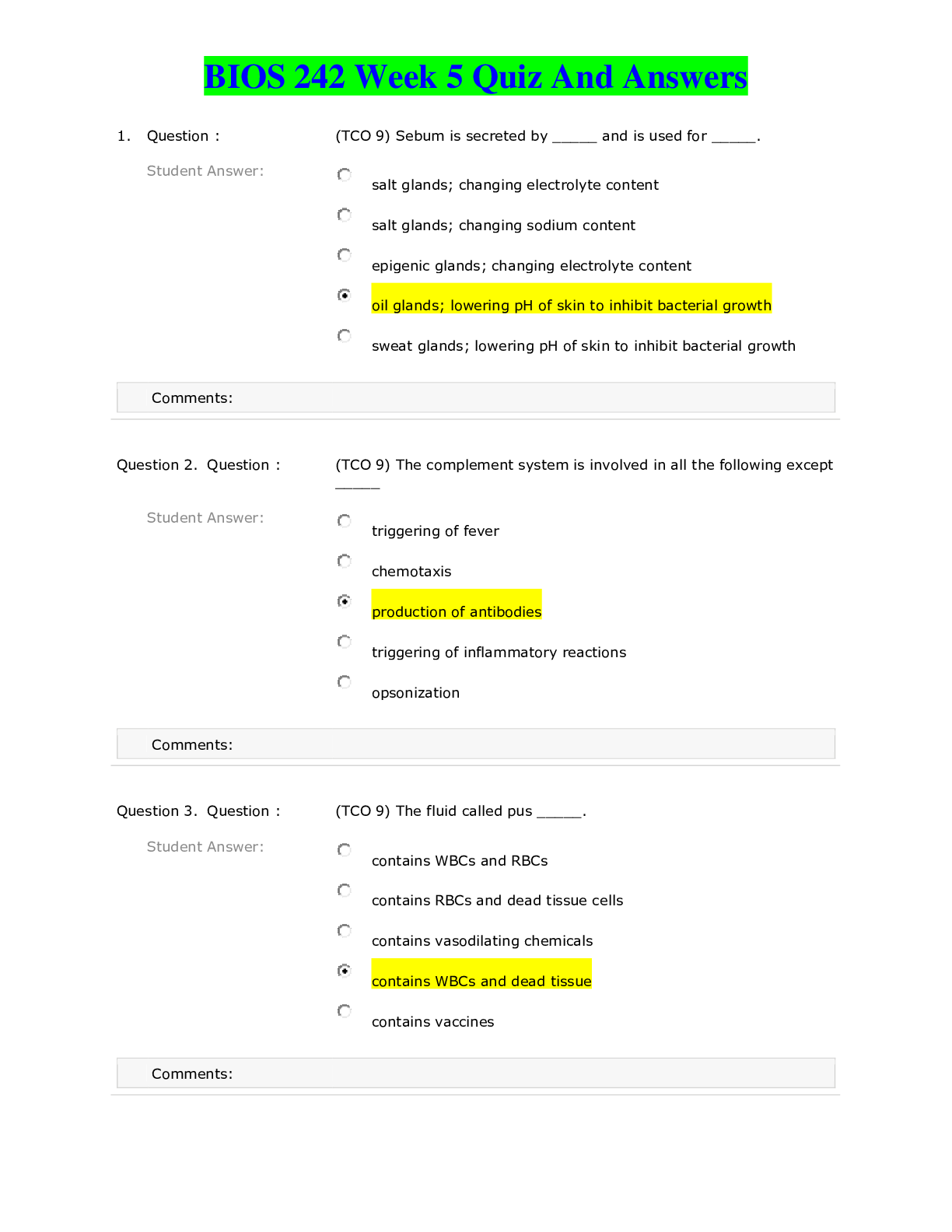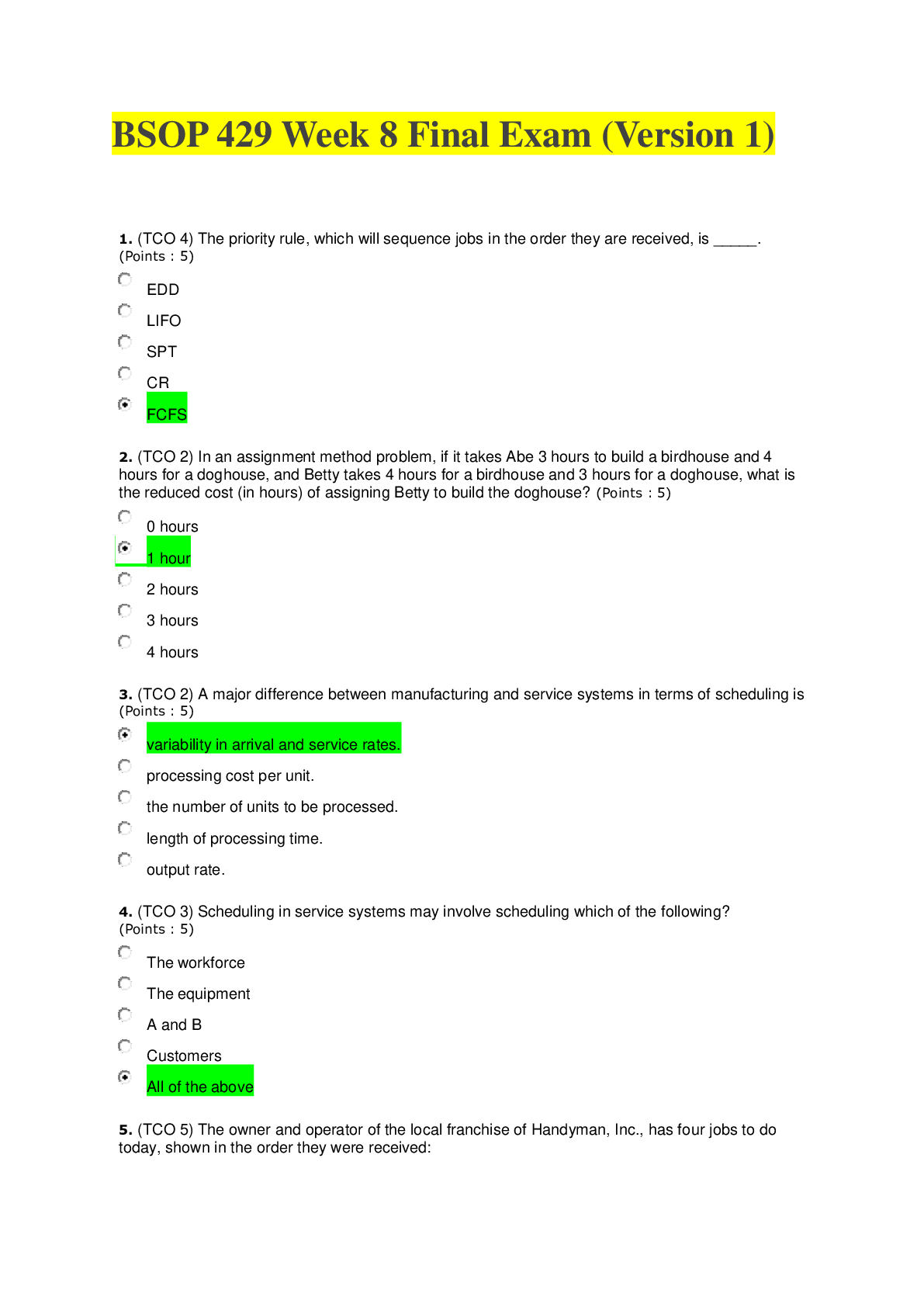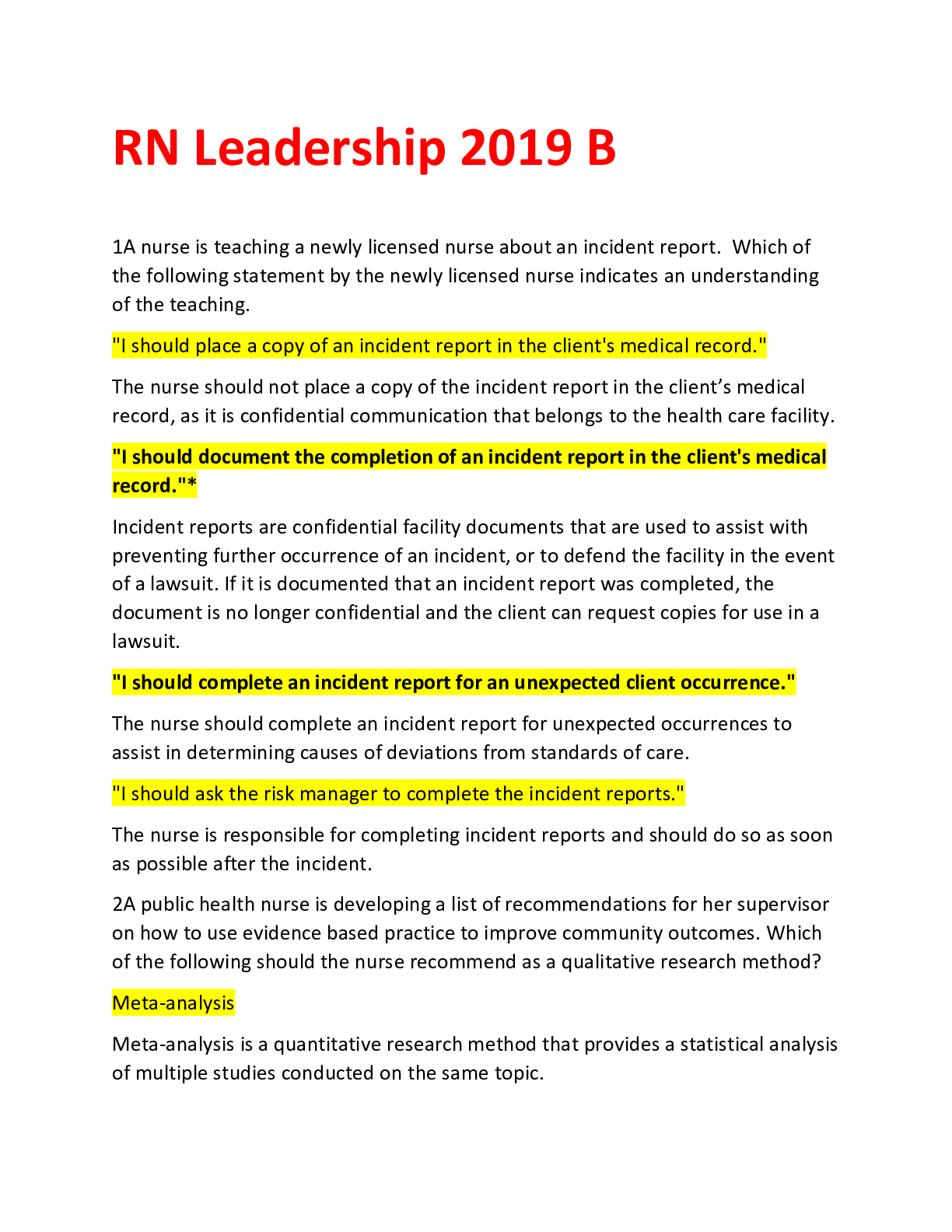Health Care > EXAM > ATI RN PROCTORED NURSING CARE OF CHILDREN FORM B QUESTIONS AND ANSWERS GRADED A (All)
ATI RN PROCTORED NURSING CARE OF CHILDREN FORM B QUESTIONS AND ANSWERS GRADED A
Document Content and Description Below
1. A nurse is providing education to the parent of a child who has cystic fibrosis and has a prolapsed rectum. The nurse should teach that which of the following is a cause of this complication: a.... Bulky stools b. Weakened rectal sphincter c. Elevated pancreatic enzymes d. Decreased intra abdominal pressure 2. A pre-schooler is admitted to the emergency department with full thickness third degree burn over 45% of his body. Which of the following actions should the nurse take first: a. Administer IV morphine b. Administer IV antibiotics c. Administer IV solutions d. Administer total parenteral nutrition 3. A nurse is providing teaching to a parent of a pre-schooler who has Tinea Capitis. Which of the following should the nurse include in the teaching: a. Apply 1 to 20 burrow’s solution compressed to the lesions b. Apply hydrocortisone cream to the lesions twice daily c. Seal and wash toys in plastic bag for two weeks d. Leave the shampoo on the scalp for 5 to 10 minutes 4. A nurse is caring for a child who has sickle cell anemia. Which of the following signs of acute chest syndrome should the nurse report to the primary care provide immediately: a. Congestive cough b. Dilute hearing c. Hct of 10g/dl d. Systolic murmur 5. A nurse is assessing a 3month old infant for suspected intussusception. Which of the following findings should the nurse expect: a. Jelly-like stool b. Board-like abdomen c. Projectile vomiting d. Oliguria 6. A nurse is planning a teaching session for parents regarding infant development. Which of the following parent activities regarding play should the nurse include in the teaching: a. Encourage the infant in one on one play b. Promote play with other infants c. Provide visual stimulation with pastel colored toys d. Give the infant a large piece puzzle 7. A school-aged child with sickle cell anemia has been admitted in vasoocclusive crisis. Which of the following assessment findings should the nurse recognize as an emergency? a. Slurred speech b. Fever of 38.30 C (1010 F) ATI RN PROCTORED NURSING CARE OF CHILDREN FORM B QUESTIONS AND ANSWERS GRADED A c. Hematuria d. Pain level of 7 on a faces scale 8. A nurse in an emergency department is assessing a child who was in a motor vehicle accident. Which of the following assessment findings require immediate intervention: a. Dilated and fixed pupils b. Disorientation to person and place c. Positive Babinski reflex d. Restless and irritable 9. A nurse is assessing a child who has sustained a head injury. During the assessment, the nurse observes clear drainage leaking from the child’s nose. Which of the following actions should the nurse take? a. Perform naso-tracheal suctioning b. Test the nasal secretions for glucose c. Maintain direct lighting on the child d. Lower the head of the bed 10. A nurse at a provider’s office is preparing a newborn for a routine heel puncture. Which of the following actions should the nurse take? a. Administer tolectin (tolmetin) prior to the procedure b. Apply EMLA cream to the heel after the procedure c. Prepare concentrated sucrose for oral administration d. Place the new born in an extended position 11. A nurse is caring for a child who has rheumatic fever. Which of the following is an indication that the child has developed carditis? a. Carotid bruit b. Chest pain c. Hypotension d. Cyanosis 12. A parent calls the clinic asking for pinworm testing information, the nurse should advise the parent to perform the test at which of the following times? a. Immediately after child has a bowel movement b. After being on a clear diet for 24hrs c. Immediately after the child awakes in the morning d. After soaking for 20 minutes in a warm bath 13. A nurse is educating the parents of an infant who has mild gastroesophageal reflux. Which dietary adjustment should the nurse recommend? a. Provide a little sprout formula b. Administer nasogastric feedings c. Thicken feedings with rice cereal d. Place infant in a lateral position for one hour after feedings 14. A nurse is teaching an adolescent client about managing asthma and using a peak respiratory flow meter. Which of the following by the client demonstrates an understanding of the teaching: a. I will use my peak flow meter whenever I feel short of breath b. I will continue to take my medication when my peak flow meter is in the green zone c. I need to use the average of three readings when I measure my flow rate d. My asthma is being controlled if my flow rate is in the yellow zone 15. A nurse is instructing the parent of an infant who has clubfeet and has cast applied. Which of the following statements by the parent indicates a need for further teaching: a. My baby will need to return to have his cast changed weekly b. I need to check my baby’s toes for any discolorations daily c. My baby will need to have surgery at 18 months if his toes aren’t fixed d. I will check the skin around my baby’s cast at every diaper change. 16. A nurse assesses an infant that is admitted for acute gastroenteritis. Which of the following is the priority finding? a. Decreased tears b. Capillary refill of 5 seconds c. Heart rate 150/min d. Dry mucous membranes 17. A nurse is planning to teach a nutrition class for preschoolers. Which of the following is an appropriate instructional strategy? (Select all that apply.) a. Offer written handouts b. Limit the teaching session to 45 minutes c. Use simple language d. Incorporate games into the lesson e. Provide concrete examples 18. A nurse is caring for a toddler who has a fever, high-pitched cry, irritability and vomiting. Which of the following is an appropriate action for the nurse to take? a. Administer 81mg of Aspirin b. Place the toddler in a cold water bath c. Place the toddler in a supine position d. Pad the rails of the bed 19. A nurse is reviewing the morning lab results for an infant who is receiving Digoxin and Lasix for the treatment of heart failure. Which of the following should the nurse report to the provider: a. Sodium 140 mEq/L b. Calcium 10.2 mg/dL c. Chloride 100 mEq/L d. Potassium 3.2 mEq/L 20. A nurse is caring for a school aged child who has an arm cast applied 8 hours ago. Which of the following findings should alert the nurse of complications related to the casting: a. Child rates pain of 5 on a scale from 0 to 10 b. Child’s hands are cool bilaterally c. Child reports tightness at the wrist [Show More]
Last updated: 2 years ago
Preview 1 out of 11 pages
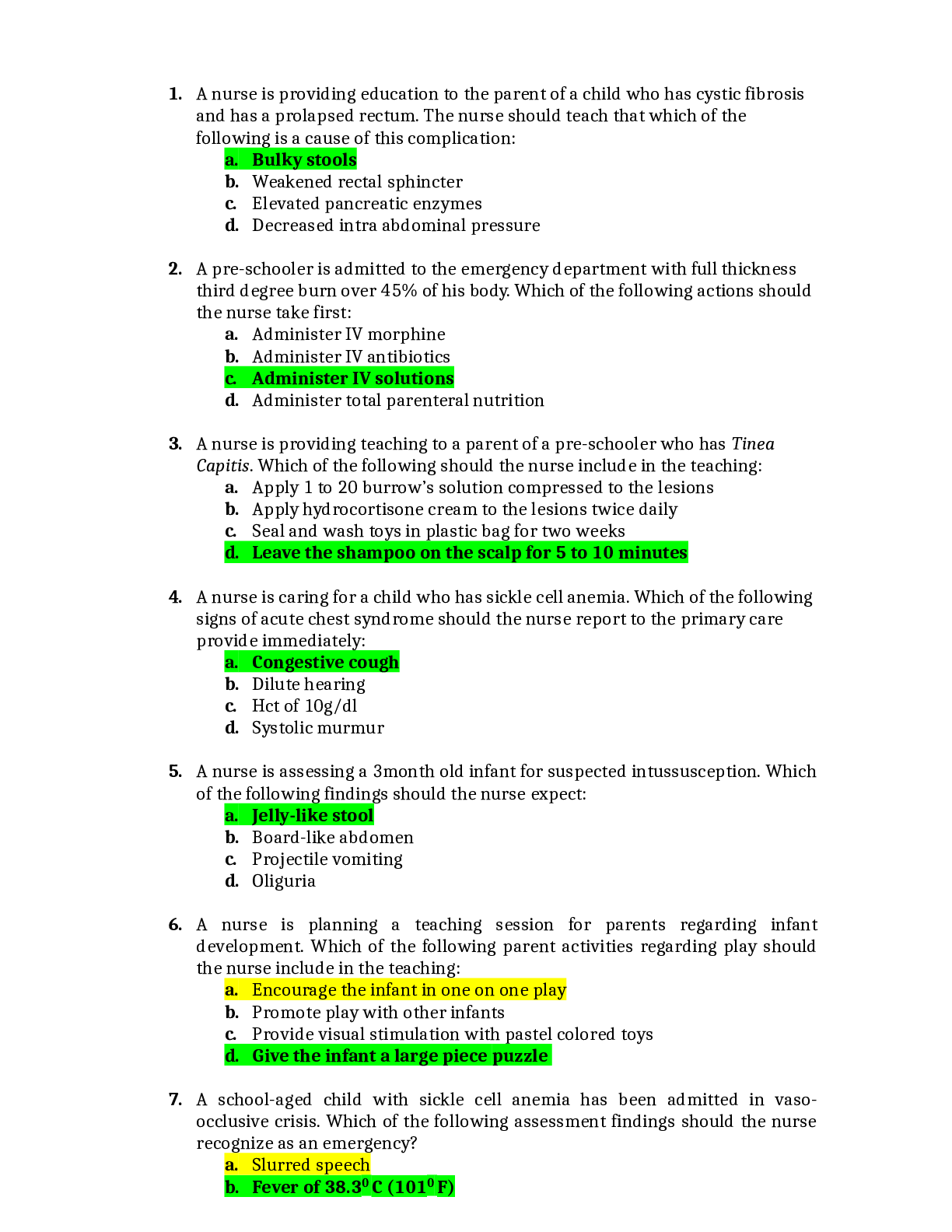
Buy this document to get the full access instantly
Instant Download Access after purchase
Buy NowInstant download
We Accept:

Reviews( 0 )
$15.00
Can't find what you want? Try our AI powered Search
Document information
Connected school, study & course
About the document
Uploaded On
Aug 27, 2022
Number of pages
11
Written in
Additional information
This document has been written for:
Uploaded
Aug 27, 2022
Downloads
0
Views
142

